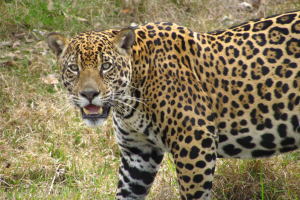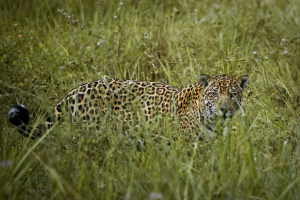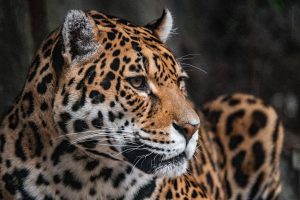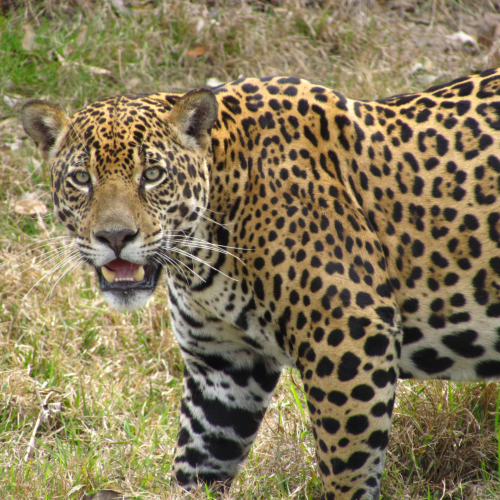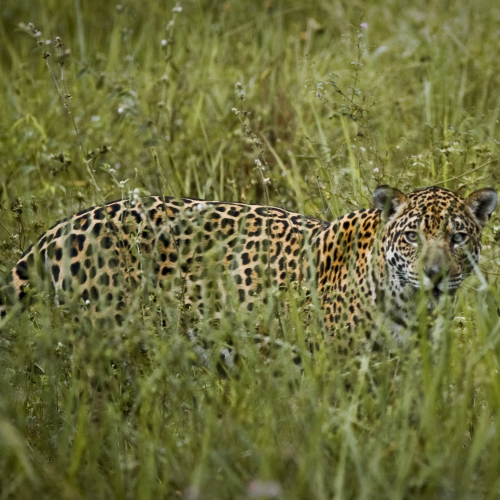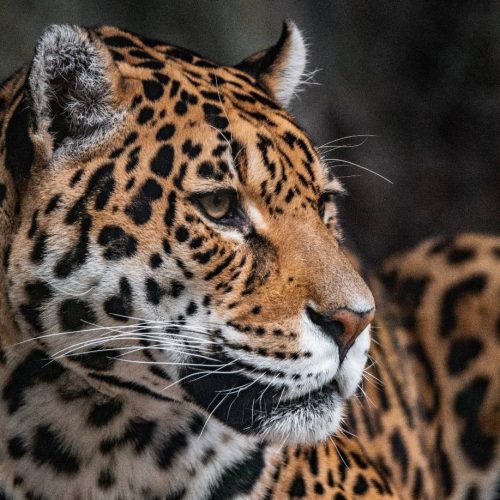Jaguar Itineraries
Seeing a Jaguar for the first time is a totally mesmerizing and an immersive experience that should be top on anyone’s bucket list. These beautiful sleek cats can be spotted resting in the shadows of trees, or swimming or playing in the wild waters of the Pantanal or the Amazon in Brazil.
The elusive Jaguars are admired for their sheer strength, power, their hunting prowess, and adaptability in these remote wetlands. Trekking through wild, tropical, and steamy jungles is where you will find the Jaguars. They can camouflage surprisingly well into their environment, but the expert guides with years of experience are fully trained to spot them.
Itinerary
Jaguar Experience
Day 1: Travel to the Pantanal
Days 3-6 : Pantanal
Day 7: Depart
Explore Brazil’s famed Pantanal wetland along its maze of channels in the Taiama Reserve, to seek out the elusive jaguar.
Day 1: Arrive São Paulo, onward flight to Cuiabá & transfer to North Pantanal.
On arrival at São Paulo Guarulhos international airport, take a connecting flight to Cuiabá. On reaching Cuiabá you will be met and transferred roughly two and a half hours drive to your accommodation in the Northern Pantanal, arriving in the late afternoon. When you arrive at the lodge you will have an opportunity to settle in, with – depending on your arrival time – the possibility of an evening excursion before or after dinner.
Accommodation: Pousada Araras Ecolodge, 2 nights
DAY 3: Morning & afternoon wildlife activities
After an early rise this morning, you have a full day of wildlife excursions by vehicle, by boat and on foot, accompanied by a naturalist guide.
DAYS:3-6: Drive to Cáceres & board riverboat; river safaris through Talama Reserve in search of jaguar
Today you transfer to the river, your base for the next four nights. The drive takes around four hours in all. On arrival at the river, you board motor boats for a short transfer to your liveaboard base which lies moored at the edge of Taiama Reserve. Then the exploring begins with an afternoon boat trip in search of jaguar with a naturalist guide.
Over the next three days, the daily rhythm remains more or less unchanged. After rising early, you head out by boat with your naturalist guide to try and locate jaguar. This is also an excellent time for birding and to see the other wildlife typical of the region. When you come across a jaguar there is no rush to move on, so you can spend as much time as possible to make the most of the photographic opportunities. Returning to the mothership in time for lunch, there’s plenty of time for a siesta in the middle of the day before heading out again in the late afternoon to look for jaguars. Dusk and dawn tend to be the best times of day for sightings – but there are no rules here. Fortunately, there is no shortage of opportunity to attempt to see these magnificent creatures.
Accommodation: Riverboat, 4-nights
DAY 7: Drive to Cuiabá & depart
Drive to Cuiabá (approximately four hours) and board a flight to São Paulo and overnight connection.
Pantanal Paradise
Day 1: São Paulo and Travel
Day 2-3 Araras Eco Lodge
Day 4: Transfer to Porto Jofre
Day 5-7: Cuiaba River
8-12 : Cristalino Private Reserve
13-14: Cuiaba and depart
Explore the Pantanal and enjoy some of the finest wildlife viewing experiences. Accompanied by expert guides, you’ll search for one of the most elusive animals – the jaguar – in the world’s most spectacular wetlands.
DAY1: Arrive São Paulo & fly to North Pantanal
On arrival in São Paulo, you have a few hours at the airport before your connecting domestic flight to Cuiabà. On arrival in Cuiabà, you will be met at the airport and transferred by road to your overnight accommodation, a journey of two and a half to three hours. By the time you arrive it will be late afternoon, so you can settle into your accommodation and relax after the travelling – ready for tomorrow.
Accommodation: Araras Eco Lodge, 3-nights
DAYS 2-3: Wildlife activities from the lodge
Over the next two days various morning and afternoon wildlife activities in the Northern Pantanal are included. There may also be a night excursion to see nocturnal wildlife. Staff at the lodge will advise you about the programme of activities.
DAY 4: Transfer to Porto Jofre
This morning you will be transferred south on the Transpantaneira road to your next destination – Porto Jofre. The drive takes roughly three hours as the road conditions aren’t the best, so you will arrive in time for lunch. After settling into your new accommodation, in the afternoon you head out for your first boat trip on the Cuiabà River and its tributaries, the Piquiri and the Três Irmãos Rivers, to try and spot jaguar.
Accommodation: Hotel Pantanal Norte, 3-nights
DAYS 5-6: Early morning boat trips on the Cuiabà River to seek jaguar; afternoon activities
Over the next two days you will set out early each morning for a boat trip on the Cuiabà River and its tributaries, the Piquiri, São Lorenço and Três Irmãos Rivers, to seek jaguar with a local naturalist guide. With luck you may also see smaller cats such as ocelot, as well as foxes, howler monkeys and caiman. Tapir, giant anteater, capybara, and peccary, all of which are rare in most of their remaining habitats, may also be seen here. You return to the lodge for lunch, and the middle part of the day is free for you to relax and/or enjoy the area’s remarkable birdlife before an afternoon activity. Staff at the hotel will advise you about the programme of activities.
DAY 7: Early morning boat trip in search of jaguar, afternoon transfer to Cuiaba
After a final early morning boat trip in search of jaguar, you prepare for departure after lunch. In the afternoon you will be transferred back along the Transpantaneira to Cuiabà, a journey of four to five hours, depending on the condition of the road.
Accommodation: Deville Hotel, 1-night
DAY 8: Fly to Alta Floresta, transfer by road & motorboat to Cristalino Private Reserve
This morning you will be transferred to Cuiabà airport in time to check in for a short domestic flight to Alta Floresta.
You will be transferred by 4×4 to a jetty (a drive of around one and a half hours). For much of this journey you will see evidence of the deforestation that has taken place in the name of agricultural development. On arrival at the jetty, you board a motorised boat for the 30 minute trip across the Rio Teles Pires into the dense rainforest of Cristalino Private Reserve. On reaching your lodge, once you have settled in, the rest of the afternoon is free to relax after an introductory briefing.
Accommodation: Cristalino Jungle Lodge, 4-nights
DAYS 9-11: Early morning & afternoon excursions
Over the next three days early morning and afternoon wildlife trips with a naturalist guide are included each day. Staff at the lodge will advise you about the programme of activities.
DAY 12: Return to Cuiabà
After a final morning sortie into the rainforest, you retrace your steps by boat and road to the town of Alta Floresta, in time to check in for the short afternoon domestic flight to Cuiabà.
Accommodation: Deville Hotel, 1-night
DAY 13: Depart Cuiabà
After a free morning, board an afternoon flight back to Sao Paulo, with an onward overnight connection back.
Brazilian Experience
DAY 1-3: SOA PAULO
DAY 3 -8: The Pantanal
Days 8-12: The Amazon
DAY 1 : SOAK IT UP IN SAO PAULO
As you touch down in sassy Sao Paulo, your private transfer is waiting to take you to your hotel. With an early morning arrival, you can check in, freshen up and prepare to hit the town. Sao Paulo is an evocative place, and as the gateway to the backwaters of Brazil it means the city boasts a melting pot of cultures. From the far-flung corners of Japan to Lebanon, everyone floods to the third largest metropolis on earth.
Admire the modern masters at the Museum of Art, visit the formal gardens and twinkling fountains at Independence Park and go gourmet at the best bistros in town.
DAY 3: JOURNEY TO PANTANAL
This morning after breakfast and a dreamy Brazilian espresso, it’s time for your transfer back to Sao Paulo airport for a swift 35-minute flight to the Campo Grande, ready for your overland journey to the Pantanal. As you leave the city of Campo Grande behind, the landscape starts to change – the Pantanal is the world’s largest wetland, covering 81,000 square miles. The skies are thick with birds, the marshes brim with reptiles and rare amphibians, and the waterholes are dense with mammals both big and small.
Arrive at your lodge and witness your first fiery Pantanal sunset with a celebratory drink in hand.
DAY 4 : NOCTURNAL JOURNEYS
Spend the dawn hours in sheer bliss at your lodge, listening to the natural world waking up. Today there is plenty of time to explore the rich surroundings. Your lodge will offer a whirlwind of activity for those who want to throw themselves into the flora and fauna of Brazil. From walking trails in the dappled forests to photography tours in special vehicles and Canadian canoe trips – experts in the eco-system will accompany you on all adventures.
When night falls, the fun doesn’t stop. Grab a flashlight for a nocturnal safari and see which critters prefer to show their faces by moonlight.
DAY 5: TRACKING JAGUARS
Today is a highlight of the tour – the chance to track down the highly elusive jaguar. Spending the day with the Jaguar Project Team gifts a rare opportunity to walk with trained trackers, and the chance to get up close and personal with the mythical creatures. For three hours in the morning, two in the afternoon, and three after dark (when the nocturnal jaguars are stirring), you can follow the trail left by the cats, check data from satellites and even locate the animals to help further the project. Few have the chance to be involved with an experience like this, making it a once in a lifetime adventure.
DAY 6: CHILL AT YOUR LODGE
Another glorious day at the lodge. Fill the hours with birdwatching tours, bicycle rides, or a jeep safari to cover even more ground in the southern Pantanal. On sweltering afternoons, there is nothing more refreshing than a dip in the pool or a wander in the shaded woodlands.
DAY 7: RETURN TO CAMPO GRANDE
Make the most of your final morning in the depths of the Pantanal – perhaps one last glide in the canoe across the mirrored waterways, or to seek out brightly plumed parrots and gossiping macaws. After a lingering lunch, your guide will return to transfer you via road back to Campo Grande. Spend the night here.
DAY 8: TOUCH DOWN IN THE TROPICS
After the shortest city break, it’s time to head back into the wild with a trip to the untamed Amazon. From Campo Grande airport you will take a six-hour connecting flight to touch down in Manaus. A guide will be waiting to take you to the docks where (weather depending) you will take a private seaplane ride to your rainforest accommodation for the next few days: another amazing lodge.
This area is known as the greatest river archipelago in the world, home to 400 islands, rare pink dolphins and wildlife filled lakes and virginal forests.
DAYS 9 TO 11: AMAZON EXPEDITIONS
For three days, you can immerse yourself in the exotica of the Amazon. Head out with a guide down the vast waterways in a traditional caboclo canoe seeking monkeys and strange birds in the overhanging trees. Travel along the Rio Negro and visit local communities. Trail the river archipelago to spot pink dolphins, and fish for razor piranhas.
Back at the lodge, you can splash in the pool, sip South American wine on the floating deck and purchase local handicrafts from the boutique selling regional handicrafts. Other activities we can arrange include piranha fishing, boat expeditions, local village tours and hiking along local trails.
DAY 12: RETURN TO MANAUS
This morning you can enjoy one last sunrise over the splendour of the Amazon before taking a transfer back to Manaus Airport for your onward journey. Chances are your flight will be via Sao Paulo again, and overnight.
Why we love Brazil
Brazil is a place where your spirit can soar into adventure. Brazil has a very welcoming nature where even strangers will have the kindness to invite you into their homes and even to their parties. The weather will have you coming back forever as its searing tropical climate accompanies you on every day. It has luscious beaches and crystalline blue oceans next to them. In the varieties of rice-based dishes you will find a meal for anyone, no matter how fussy including meals like feijoada, pasteis de camarao, and moqueca capixaba. Not to mention the delightful Churrasco meat. As you are walking along the streets of Brazil you will hear the constant soulful tones of the live music of samba. Not to mention the intense soul of experiencing the football culture of Brazil with its incendiary passion. It is also beautiful how much of a melting pot Brazil is for other cultures as it includes many intersections of different peoples. There are also multiple religions here so it is an open place for any believer. This is combined with the infinite magic of the Pantanal itself which is something that you cannot miss in its awe-inspiring waterways with the sightings of magnificent jaguar, not to mention the Amazon rainforest with its multitudes of exotic animals. Brazil is a place that is impossible to not love.
About The Jaguar
The Jaguar is the third largest cat in the world, after tigers and lions, but the strongest pound for pound. They are often confused with a leopard, but the markings of a Jaguar have an additional black spot inside the rosette pattern on their fur.
Jaguars are usually solitary (except when mating) and are very territorial, marking their areas with urine and marking trees with their claws. They swim well in the rivers, scour for food such as fish and turtles, and kill caiman by piercing the skull with one of the most powerful bites in the animal kingdom.
Females have litters of one to four cubs, which are blind and helpless at birth. The cubs stay with their mother for approx. two years whilst she teaches them to hunt and defend themselves.
‘Jaguar’ stems from the Native American word ‘yaguar’, which means ‘he who kills in one leap’.
Facts About the Jaguar
Threatened species
COMMON NAME: Jaguars
SCIENTIFIC NAME: Panthera onca
TYPE: Mammal
DIET: Carnivore
AVERAGE LIFE SPAN IN THE WILD: 12 to 15 years
SIZE: Head and body: five to six feet. Tail: 27.5 to 36 inches
WEIGHT: 100 to 250 pounds
Best Places to see the Jaguar
The Exotic Wonder of The Pantanal
Located in the south of the Brazilian states of Mato Grosso and Mato Grosso do Sul, this is a massive network of wetlands that is shadowed by the amazon. It is 50 percent larger than the United Kingdom and is the place with the greatest chance of seeing the Jaguar in person. The reason this is so high is that jaguar needs three things to thrive: food, water and protection. The biodiversity of the Pantanal gives a solid way to provide these three things for these jaguars with over 600 bird species, 90 land mammals, 270 fish species and over 1000 types of butterflies and insects. It contains an intricate and perfectly balanced food chain, at the top of which sits the jaguar. In the rainy season, most of the rainwater-filled ponds and lakes have receded, turning the Pantanal into an immense grassland. This forces a majority of the animals to head for the larger waterways such as the Cuiaba, Piquiri or Three Brothers rivers, which in turn ensures an important concentration of jaguars, well aware of the abundance of prey.
Cuiabá River, northern Pantanal, Brazil
This is the world’s largest wetland spanning some 170 thousand kilometres which makes it the most realistic place to see the jaguar in the entire world, the jaguar watching experience lasts longer than anywhere else here. To maximise your viewing experience, make sure to take a boat ride on the Cuiaba River towards the end of the dry season as the jaguar’s head to the riverbanks to hunt capybara and caiman. The Cuiaba River is a remote spot that has attracted fishermen for years. Fishermen don’t pay much attention to the jaguar here, so an entire generation of jaguar have grown up with fishing boats passing by them and not disturbing them, meaning they won’t run from you either. As this is one of the only places jaguars feel comfortable it means you can get hours watching them playing with their cubs, hunting and sleeping. This all seems rather crazy, as most professional cameramen spend years trying to get minutes filming these elusive and astonishing creatures. At Wildlife Escapes we can organise for you to go on one of these boat tours and stay in a nearby accommodation as part of your luxury travel experience.
Caiman Ecological Reserve, southern Pantanal, Brazil
At the Caiman Ecological Reserve in southern Pantanal there is the on-going Oncafari project which fosters ecotourism, wild jaguars and releases the rescued cats into the wild. There is high end accommodation here and the guests report sighting rates as high as ninety percent! This is a life changing experience as you work with the team on habituating individual cats, jaguars are reportedly seen almost daily during the dry season. You will also see various other amazing creatures such as anteaters, hyacinth macaws, capybaras and blue fronted parrots. The land itself is a fifty-three-hectare oasis that is based on the conservation of fauna, flora and the Pantanal culture. It is a world heritage site which is also Brazil’s most well-preserved biome with 80 percent of the vegetation preserved. The reserve offers multiple kinds of activities next to the jaguar viewing experiences such as horseback riding and canoe tours. The ecotourism of the reserve is encapsulated in the nature of its jaguar viewing experiences which changes the way the wild jaguars see the vehicles as a threat. This makes it sustainable, progressive and even more worthwhile.
The Pantanal Conservation Area (Brazil)
This large complex in the Brazilian Pantanal includes the Pantanal Matogrossense National Park in southwestern Mato Grosso as well as the Acurizal, Doroche, and Penha special reserves. The national park, which sprawls between the Paraguay and Cuiabá rivers, offers sightings of hyacinth macaws, spoonbills, and other birds as well as jaguars, giant otters, capybara, and pampas deer. The Pantanal Conservation Area consists of a cluster of four protected areas with a total area of 187,818 hectares. Located in western central Brazil at the south-west corner of the State of Mato Grosso, the site represents 1.3% of Brazil’s Pantanal region, one of the world’s largest freshwater wetland ecosystems. The headwaters of the region’s two major river systems, the Cuiabá and the Paraguay rivers, are located here, and the abundance and diversity of its vegetation and animal life are spectacular.
Taiama Ecological Reserve (Brazil)
Jaguars are also on the potential wildlife-viewing checklist at this refuge, which also supports other Pantanal mammals such as marsh deer and giant otters as well as 200-plus bird species. The largest cat in the Americas has found peace and tranquillity for their survival with the creation of the Taiamã Ecological Station. This magnificent place is an island with many other little rivers protected, with fishing forbidden all over the area. Due to the remoteness of the area, Jaguars there are less used to human beings, so, in spite of being harder to observe them, this is compensated by the pleasure of not having a dozen other boats surrounding you. The large diversity of aquatic environments has species of wildlife that includes the Giant-river Otters – the ‘wolves of the rivers’ as well as Tapirs and many Capybaras and Caiman. Taking a fast motorboat equipped with radio-communication is the best and most guaranteed way to see Jaguars. The Jaguars could be hidden, just resting on the riverbanks, or playing on the beaches, or hunting Caimans and Capybaras. So, this acts as a contrast to the river experience we offer.
Top Properties:
Caiman lodge
Caiman Lodge is at one of the best spots in the reserve, really close to the Laguna Grande and reachable by canoe all year long, not depending on the season. The lodge accommodates up to 40 people in three individual guest huts; each hut has 2 – 4 double or triple bedrooms (as required) each with its own private bathroom and shower. There is also a relaxing area, hammocks and an amazing tower (3 floors are fit with triple rooms as those mentioned above) with a great view over the lagoon and the jungle from the 7th top floor. It offers many activities such as hiking trails, Caiman tours, canoe tours, nocturnal adventures and obviously the astonishing safaris.
Araras Eco Lodge
From this self-sustainable lodge, you will have the opportunity of excellent bird watching, walking on trails in primary forest and on suspended walkways over wet areas. Here you can go canoeing, explore fields and forests on horseback, take day and night photo safaris in appropriate vehicles, and much more, everything with the permanent assistance of naturalist guides, specialised and fluent in several languages.
SouthWild Jaguar Suites
The suites are uniquely set floating just off the riverbank of the incredible Piquirí River deep within the Pantanal. Each of the six suites cover an area of 30m² and are complete with your very own private porch area, perfect for relaxing with a sundowner after an exciting day jaguar spotting. All of your meals are included during your stay on the SouthWild Jaguar Suites. The dishes are made from as much locally sourced, fresh ingredients as possible and can cater for a number of diets- with plenty of notice. The main focus during your stay here is on spotting the elusive jaguar. Your days will be filled with expert led nature walks and boat tours. Each day there are three boat tours along the river looking out for jaguars, all equipped with radios ensuring you have the best chance of sightings. SouthWild prides itself on guests enjoying an average of three jaguar sightings per day in 2017.
Top tips for visiting Brazil
1 – Protect yourself
It’s good to start with the basics: protecting your body with the right creams and products and take the necessary vaccines.
You do not want to have sunburn or a million mosquito bites when visiting Brazil.
2 – Be careful with street food and drinks
It is good to be careful with street food and drinks, especially mixed seafood which can be hard to identify. And it might be a good idea to avoid cheap wine or unknown alcoholic drinks.
3 – Watch your belongings
Like most cities in the world, you need to look after your valuables and it is best to avoid wearing valuables where others can see them, such as cameras, jewellery, credit cards and cash. It’s particularly valid when you are at the beach, where you should never leave your belongings unattended.
4 – Withdraw money before 10:00 PM
Be aware that you can’t withdraw money from ATM’s after 10:00 PM, as they’re closed because of local regulations.
5 – Take official taxis and use service from reliable guides
On the streets, do not accept services from unmarked street taxis and city guides. It’s important that you know which routes you want to use when travelling, as getting help in English is not always easy and can lead you in the wrong direction.
8 – Portuguese is the official language
It’s also important to remember that Portuguese is spoken in Brazil and not Spanish (and it’s not called Brazilian). Do not use the OK hand gesture because it means something pretty rude in Brazil….
10 – Pack adequately
Brazil is a huge country with several different climate areas.Therefore, you must also consider which parts of the country you are planning to visit, and when, in order to pack the right clothing and shoes. You want to avoid freezing in the mountains or getting sunstroke on a beach.
Best time to visit
DEC-FEB
The pleasing sunny weather presents crystal clear visibility. The forest gets greener and the river begins to rise and canoeing is possible again on the bahias and small rivers. These are very good months for observing mammals inside the forest.
MAR-MAY
The most beautiful water scenery is in the months of March through May. Migrating bird from Northern America are now passing in the Pantanal. The flora is blooming, showing marvellous pink flowers of heliconia’s, bromeliads and orchids. One of the world’s least-known waterbirds, the Least Bittern, is often seen during this season. The river reaches its highest level and mammals that normally hide near the banks can be more easily viewed away from them. This period also offers most beautiful sunsets of the entire year.
JUNE-DEC
Generally speaking, the best time to visit is between 1 June and 31 December. The last half of July and the first half of August feature an astounding wading bird concentration just 15 minutes south of the town of Poconé at some of the first bridges on the Transpantaneira Road. The Giant Otters tend to be visible daily at close range from early June through Dec. The Jabiru Stork nests are active from July through early November. The most colourful flowering trees are available in July (the yellow-flowering Voychysia divergens) and August (the pink-flowering and yellow-flowering Tabebuia species). So far, our four years of field research have shown that July through November are the best months to see Jaguars on the rivers.
The Value of Jaguar Watching
When you observe these creates, you contribute to their health and existence through ecotourism. You are not only seeing these magnificent mammals for your own experience and enjoyment, but also to safeguard their existence as a species. If you see them in the wetlands of the Pantanal River next to friendly fishermen or at the ecological reserve where you can watch them be saved, you will find the experience of viewing these creatures as something that will alter how you see nature and yourself forever. Contact our wildlife Escape experts today and we can help you experience the magic!

